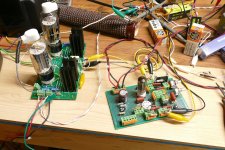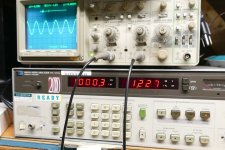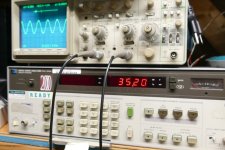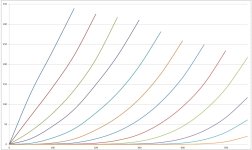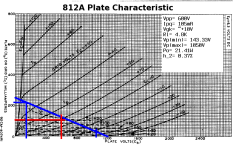I mocked up a version of Michael Koster's Schadeode and tried it with several different tubes. My power supply maxed out at 550 volts and the output transformers were rated for 80 ma.
https://www.diyaudio.com/community/threads/set-build-recommendation.370350/#post-6599691 see post 18
After the post above I tried a KT88 at 80% plate dissipation and got 16 watts at 3% distortion. I used a 5k impedance transformer for all tests. With a higher B+ voltage or a transformer rated for 100ma I expect I could have got 18 watts but the difference would be negligible. I did not try this experiment with a 3.5k impedance transformer which might be more ideal for the KT88.
I liked the sound as much as all of my other all tube SE amps with the exception of my Mingda 300B amps.
Steve
https://www.diyaudio.com/community/threads/set-build-recommendation.370350/#post-6599691 see post 18
After the post above I tried a KT88 at 80% plate dissipation and got 16 watts at 3% distortion. I used a 5k impedance transformer for all tests. With a higher B+ voltage or a transformer rated for 100ma I expect I could have got 18 watts but the difference would be negligible. I did not try this experiment with a 3.5k impedance transformer which might be more ideal for the KT88.
I liked the sound as much as all of my other all tube SE amps with the exception of my Mingda 300B amps.
Steve
@Kay Pirinha,It's ultralinear, not SET.
Best regards!
Do you call this “not SET”?
https://cdn.xingosoftware.com/audioxpress/images/fetch/dpr_2,w_1200/https://audioxpress.com/assets/upload/images/1/20180725140033_Figure1-MillettSE-E-LinearAmp.jpg
Confusion, Confusion, Confusion.
What is in a [Proper] name?
A 4-65A is a True Tetrode
A KT88 is a Kinkless Tetrode. What makes it Kinkless is adding Beam Formers to what would otherwise be a True Tetrode (but it is not).
That makes it a 5 element tube.
But please do not call it a Pentode!
Pentodes were protected by patents; so the Beam Power tube was invented (still 5 elements, but "Pentode" was a registered name, Correct?
True Pentodes have a Suppressor Grid. 5 Elements, Pentode.
There are no beam formers in a Pentode.
Then Patents ran out, so everybody did whatever they liked to do. Confusion Rules!
If you use the wrong name for a tube, I will not know for sure what you are talking about.
The next terms (names) are now up for discussion . . .
Single Ended and Push Pull
Single Ended, whether done with a Triode, True Tetrode, Kinkless Tetrode, Beam Power, or Pentode are All Single Ended.
Single Ended, as in when there is only one phase from the output tube(s) to the output transformer primary.
If there is more than one output tube in parallel, it is called a PSE, Parallel Single Ended (one phase to the output transformer primary).
Push Pull, whether done with a Triode, True Tetrode, Kinkless Tetrode, Beam Power, or Pentode are All Push Pull.
The output transformer primary receives 2 (two) phases, preferably 180 degrees over most, if not all, of the 20Hz to 20kHz range (not always a perfect 180 degrees). But 180 degrees is the intent.
Ultra Linear is when the output transformer has a primary Tap for Single Ended, or primary Taps for Push Pull;
The Tap(s) puts a percentage (%) of the plate voltage swing, and applies it to the output tube Screen (g2).
Guess what?
There is Ultra Linear Push Pull, and there is Ultra Linear Single Ended.
Hopefully, somewhere in my above statements, I have cleared a few things up, but I am sure there will still be some misunderstanding.
Just my opinions.
What is in a [Proper] name?
A 4-65A is a True Tetrode
A KT88 is a Kinkless Tetrode. What makes it Kinkless is adding Beam Formers to what would otherwise be a True Tetrode (but it is not).
That makes it a 5 element tube.
But please do not call it a Pentode!
Pentodes were protected by patents; so the Beam Power tube was invented (still 5 elements, but "Pentode" was a registered name, Correct?
True Pentodes have a Suppressor Grid. 5 Elements, Pentode.
There are no beam formers in a Pentode.
Then Patents ran out, so everybody did whatever they liked to do. Confusion Rules!
If you use the wrong name for a tube, I will not know for sure what you are talking about.
The next terms (names) are now up for discussion . . .
Single Ended and Push Pull
Single Ended, whether done with a Triode, True Tetrode, Kinkless Tetrode, Beam Power, or Pentode are All Single Ended.
Single Ended, as in when there is only one phase from the output tube(s) to the output transformer primary.
If there is more than one output tube in parallel, it is called a PSE, Parallel Single Ended (one phase to the output transformer primary).
Push Pull, whether done with a Triode, True Tetrode, Kinkless Tetrode, Beam Power, or Pentode are All Push Pull.
The output transformer primary receives 2 (two) phases, preferably 180 degrees over most, if not all, of the 20Hz to 20kHz range (not always a perfect 180 degrees). But 180 degrees is the intent.
Ultra Linear is when the output transformer has a primary Tap for Single Ended, or primary Taps for Push Pull;
The Tap(s) puts a percentage (%) of the plate voltage swing, and applies it to the output tube Screen (g2).
Guess what?
There is Ultra Linear Push Pull, and there is Ultra Linear Single Ended.
Hopefully, somewhere in my above statements, I have cleared a few things up, but I am sure there will still be some misunderstanding.
Just my opinions.
UL is Acrosound's precise patented specification for a determined % of screen tap per any specific tube they have set it for. Everyone calls any screen tapped tranformer UL and that is wrong. UL is defined by Acrosound, not Dynaco, and it is only applicable to specific combinations of tap % to tube types. The term screen tap should apply to every thing else. There is no UL specification for types like KT 88, KT120, and many others because the UL performance specification has not been determined for those. One needs to research the UL types per Acrosound if you really want to apply UL specification to an amp.
The GEC detailed spec sheet for the KT88 gives specs, and even curves for the tube in Ultralinear mode. The circuit supplement section includes a section on Ultraliear and presents three different amp designs of 30, 50 and 100 watts of power output with schematics and parts lists.
Attachments
I have not mentioned the UNSET design here, though other posters have, since it can be reasoned by many that it is not a true triode design. The curves generated by the composite pentode / mosfet pair however do look just like triode curves. It is best applied to TV sweep tubes, and a pair of parallel connected 26HU5's can be seen here cranking out 35 watts at 1.23% THD in SE on about 500 volts.
Many years ago I built an amp that ran 211's or 845's on 1050 volts. it ran into A2 and made 30 watts with 845's. On most music it was stunning. Now I might be the outlier who expects every amp he makes to be capable of playing Pink Floyd or Metallica at full tilt, and that's where the big triode amp fell short. 845's did better than the 211's in the loud bass heavy rock department, but I sold the amp last year in favor of a 15 watt UNSET amp which is likely to soon be replaced by a BIGGER UNSET amp. After sitting on a shelf for 18 years, I have finally found a way to squeeze some decent sound through those big Hammond 1628SEA's.
The curves shown in the picture were hand traced on a 6GF5 TV sweep tube. The resolution of the variable power supplies and Harbor Freight DVM's used is the reason for the slight offset and bend in the purple trace near the top.
Many years ago I built an amp that ran 211's or 845's on 1050 volts. it ran into A2 and made 30 watts with 845's. On most music it was stunning. Now I might be the outlier who expects every amp he makes to be capable of playing Pink Floyd or Metallica at full tilt, and that's where the big triode amp fell short. 845's did better than the 211's in the loud bass heavy rock department, but I sold the amp last year in favor of a 15 watt UNSET amp which is likely to soon be replaced by a BIGGER UNSET amp. After sitting on a shelf for 18 years, I have finally found a way to squeeze some decent sound through those big Hammond 1628SEA's.
The curves shown in the picture were hand traced on a 6GF5 TV sweep tube. The resolution of the variable power supplies and Harbor Freight DVM's used is the reason for the slight offset and bend in the purple trace near the top.
Attachments
The GEC detailed spec sheet for the KT88 gives specs, and even curves for the tube in Ultralinear mode. The circuit supplement section includes a section on Ultraliear and presents three different amp designs of 30, 50 and 100 watts of power output with schematics and parts lists. Just any screen tap is not an UL tap.
With all due respect to GEC, I've never seen an Acrosound specification for any of their UL transformers for KT88, or circuit published by Acro with KT88 and the specific OPT for that type, or any other catalog spec for KT 88. It seems GEC took the liberty everyone else takes and applied a common tap % and used Acrosound's UL patent term out of license. I may be wrong, of course, about no KT88 specification published by Acro but I'd very much like to see an Acrosound document to support KT88 UL tranny screen tap specs. Just any screen tap is not the same as UL.
Last edited:
Nothing against Ultralinear (other than the fact that it has a misleading name), but wasn't the question about a single-ended triode amp and how to make one that makes 15W?
Since max theoretical output for a class-A inductively-loaded output stage is going to be 50%, and that is only going to occur if you can get the plate to come down to 0V, you are going to have to start with a tube with a 30W plate plus some more. If you want to stick to as small a triode as possible, you are going to have to drive the grid positive all the way to saturation. I think an 811A would be a great choice. There are plenty of new production and NOS around. You might be able to get a 300B to do it but you'd be punishing it a bit.
If you want to stick to class A1, you are going to have to get an even bigger tube since you won't be able to go past the Vg=0 line. You'll have to go with a bigger transmitting triode and a higher, more dangerous B+.
Since max theoretical output for a class-A inductively-loaded output stage is going to be 50%, and that is only going to occur if you can get the plate to come down to 0V, you are going to have to start with a tube with a 30W plate plus some more. If you want to stick to as small a triode as possible, you are going to have to drive the grid positive all the way to saturation. I think an 811A would be a great choice. There are plenty of new production and NOS around. You might be able to get a 300B to do it but you'd be punishing it a bit.
If you want to stick to class A1, you are going to have to get an even bigger tube since you won't be able to go past the Vg=0 line. You'll have to go with a bigger transmitting triode and a higher, more dangerous B+.
That might actually be the most effective choice for a SET because unlike Class A1, Class A2 can easily get to 40-45% plate efficiency like a pentode. As you say, well selected Chinese 811 can be really good and NOS ones are still relatively affordable. Choke loaded and DC coupled cathode follower as a driver, which does not require an additional negative bias but just a small choke with the right amount of DC resistance (Hammond has some good ones) and 16R tap from the OPT for some 5-8 dB cathode feedback to get typical zero fbk triode DF. Michimori has made a good number of amps like this over time. Maybe with 450V one needs a bit less than 5K for 15W and always stay in A2 (total load will increase when CF is on). But I haven't checked that.I bet you could achieve 15W out with an 811A at ~450V B+ or so.
With 600V can get up to 22-24W like above: http://www6.plala.or.jp/Michi/4P1L 811A 8/Third version of the 811A amp.htm
Last edited:
Choke loaded and DC coupled cathode follower as a driver, which does not require an additional negative bias but just a small choke with the right amount of DC resistance (Hammond has some good ones) and 16R tap from the OPT for some 5-8 dB cathode feedback.
This is exactly how I designed my recent 808 SE project. I use pentode wired 807s as CF drivers and I'm very happy with the results so far, even though I only get ~7W/ch at the moment due to a mismatch between the high-ish plate load (5k) and low-ish plate voltage from the prototype power supply (~400Vdc).
Just as with the 811 SET I built twenty years ago, the biggest challenge was to design filament power supplies that can deliver 4A dc without hum, mechanichal buzz or caps that gets slow-boiled by the ripple currents.
The simple classic cathode follower works great for true Class A2 (i.e. never crossing the negative grid field) because, as long as the power tube doesn't go below the knee, its input impedance is fairly constant and can be addressed. There is no sudden change in distortion like when crossing from negative grid field to positive. In classic Class A1, going into positive grid is only convenient if moderate (normally 3-5V with typical low mu triodes). After that distortion can be still kept low with a proper driver but shows a sudden change in spectrum composition anyway.
Not going below the knee also works against speaker load which is more critical when impedance drops (and the tube stays even more above the knee).
30W with 630V: http://www6.plala.or.jp/Michi/Renewal838SE/Renewal838SE.html
Not going below the knee also works against speaker load which is more critical when impedance drops (and the tube stays even more above the knee).
30W with 630V: http://www6.plala.or.jp/Michi/Renewal838SE/Renewal838SE.html
Last edited:
This is like going on a campaign when Everyone calls them a Band-aid when it's actually an adhesive bandage, or a Q-tip when it's actually a cotton swab... When someone says it's a UL tap, does anyone actually think "Oh this must be Acrosound's precise patented specification?"UL is Acrosound's precise patented specification for a determined % of screen tap per any specific tube they have set it for. Everyone calls any screen tapped tranformer UL and that is wrong.
Maybe the patent has just expired by today? Additionally, I'm not aware of any Acrosound complain about the misuser of their patent or it's specs, despite they might have reaped some earnest amount of money especially form the big players, such as GE.UL is Acrosound's precise patented specification for a determined % of screen tap per any specific tube they have set it for. Everyone calls any screen tapped tranformer UL and that is wrong. UL is defined by Acrosound, not Dynaco, and it is only applicable to specific combinations of tap % to tube types.
Anyway, this is just one example imho of hair splitting on the term.
Best regards!
Yep, that was the question.Nothing against Ultralinear (other than the fact that it has a misleading name), but wasn't the question about a single-ended triode amp and how to make one that makes 15W?
811 Loadline (attached)
812 Loadline (attached)
These two types have very similar characteristics so far as plate dissipation is concerned. The 811 is a "zero bias" RF triode that's seen in ESSSSS-loads of RF amp designs. The 812 has lower u-factor and rp for better performance as an AM plate modulated RF final. Both can make ~15W as an SE triode audio amp, though that'll require going Class A2. A MOSFET source follower can slap those grids silly.
As with anything, the devil is in the details. The A Number One "Devil" is the OPT. I gave up on this particular project due to there being no OPTs. Having the OPTs as a custom job was out of the qiestion since I couldn't find a supplier who could guarantee the specs needed for sonic excellence. Single ended OPTs really are a black art.
Attachments
Acrosound Ultra Linear: According to the % of the Tap, the tube type, the output transformer primary impedance, and with the secondary being loaded by a resistance that matches the secondary tap rating. An 8 Ohm load resistor on the 8 Ohm tap for example.
The varying impedance of loudspeakers, which is capacitive, inductive, non-8 Ohm resistive, a combination of 2 or 3: L, C, and R;
Anything but a flat resistive load line, too high of an impedance, too low of an impedance, or worse yet, an Elliptical load line.
The varying reactive load will also disturb the phase of global negative feedback that comes from the output transformer secondary.
Primary to secondary leakage inductance is one reason for that.
You can hold Acrosound to their "promises" about Ultra Linear, as long as you use a proper non-inductive load resistor.
Do not connect a loudspeaker, or Acrosound will lose like most do when they pull a one-armed bandit machine in Las Vegas.
Remember, circuit topologies that are different than Ultra Linear, they also suffer from the same problems that Ultra Linear does.
If you can not enjoy listening to your stereo system, either get a new system, stop listening, or . . . lighten up a little and Enjoy The Music.
(If you look for dirt under the rug, it will be there).
The varying impedance of loudspeakers, which is capacitive, inductive, non-8 Ohm resistive, a combination of 2 or 3: L, C, and R;
Anything but a flat resistive load line, too high of an impedance, too low of an impedance, or worse yet, an Elliptical load line.
The varying reactive load will also disturb the phase of global negative feedback that comes from the output transformer secondary.
Primary to secondary leakage inductance is one reason for that.
You can hold Acrosound to their "promises" about Ultra Linear, as long as you use a proper non-inductive load resistor.
Do not connect a loudspeaker, or Acrosound will lose like most do when they pull a one-armed bandit machine in Las Vegas.
Remember, circuit topologies that are different than Ultra Linear, they also suffer from the same problems that Ultra Linear does.
If you can not enjoy listening to your stereo system, either get a new system, stop listening, or . . . lighten up a little and Enjoy The Music.
(If you look for dirt under the rug, it will be there).
The Edcor 5k SE transformers are actually pretty good transformers for the money. They were 3dB down at 60kHz if I recall correctly. After I get done assembling my current project I'm going to do a thorough comparison between them and the similarly sized Electra-Print 5k transformers that I have.As with anything, the devil is in the details. The A Number One "Devil" is the OPT. I gave up on this particular project due to there being no OPTs. Having the OPTs as a custom job was out of the qiestion since I couldn't find a supplier who could guarantee the specs needed for sonic excellence. Single ended OPTs really are a black art.
Actualy it is a SE Ultralinear,It's ultralinear, not SET.
Best regards!
SE is for Single Ended
- Home
- Amplifiers
- Tubes / Valves
- Feasibility of getting 15W out of a SET tube design?
